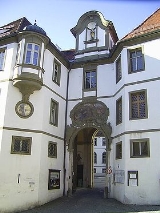
St. Mang's Abbey, Füssen
Encyclopedia
St. Mang's Abbey, Füssen or Füssen Abbey was a Benedictine monastery in Füssen
in Bavaria
, Germany
.
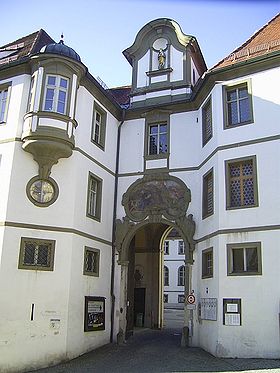
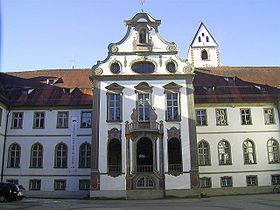 The Benedictine abbey of Saint Mang was founded in the first half of the 9th century as a proprietary monastery of the Bishops of Augsburg
The Benedictine abbey of Saint Mang was founded in the first half of the 9th century as a proprietary monastery of the Bishops of Augsburg
. The reason for its foundation goes back to the hermit
Magnus of Füssen
(otherwise known as Saint Mang), who built a cell and an oratory here, where he died on 6 September, although there is no record of which year.
The saint's body, amid miracles, was discovered uncorrupted, a proof of his sanctity, and the veneration of St. Mang was the spiritual basis of the monastery.
The foundation was not however solely spiritually motivated; there were practical political reasons underlying it as well. The monastery's key position not only on the important medieval
road from Augsburg across the Alps
to Upper Italy
but also in the Füssen Gap ("Füssener Enge", the point where the Lech River
breaks out of the Alps) gave it an immense strategic value, which made it of political concern both to the Bishops of Augsburg and to the Holy Roman Emperor
s.
The history of the abbey in the Middle Ages
is principally marked by the efforts of the religious community to maintain a life true to the Rule of St. Benedict amidst the various pressures caused by external social developments. Over time therefore the monks repeatedly embraced various reforms and reforming movements intended to bring about a return to the essentials of the Benedictine life. These reforms mostly resulted in spiritual and economic growth and an increase in the headcount, which in turn brought more building and commissions of artwork.
The energy of the Counter-reformation
found lasting expression in the construction of an enormous Baroque
abbey complex between 1696 and 1726, commissioned by Abbot Gerhard Oberleitner (1696-1714), which still today, along with the High Castle (Hohe Schloss), characterises the town of Füssen.
The architect Johann Jakob Herkomer (1652-1717) succeeded in turning the irregular medieval abbey premises into a symmetrically organised complex of buildings complex. The transformation of the medieval basilica
into a Baroque
church based on Venetian
models was intended to be an architectural symbol of the veneration of Saint Magnus. The entire church represents an enormous reliquary
. For the first time in South German Baroque construction the legend of the local saint inspires the suite of frescoes throughout the entire church. The community at the time also set out to make the new church the envy of connoisseurs for the quality of its artworks.
In the second half of the 18th century the community returned to their spiritual, intellectual and social duties with renewed vigour: the cure of souls, scholarship, music and education.
Although the abbey was never able to obtain the coveted Reichsunmittelbarkeit (independence of all lordship except for that of the Emperor), it had a decisive influence as a centre of lordship and economy, cultural and faith life, on Füssen and the whole region.
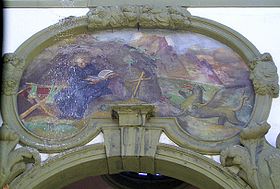
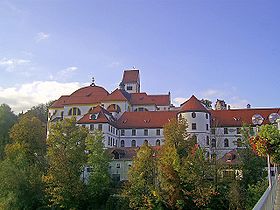
and the Peace of Lunéville, the princes of Oettingen-Wallerstein were awarded possession of St. Mang. On 15 January 1803 Princess Wilhelmine ordered Abbot Aemilian Hafner to dissolve the abbey and vacate the premises by 1 March of that year.
The contents of the library were shipped off to the new owners down the Lech on rafts. Most of the items are now in the library of the University of Augsburg
, except for a small collection of especially valuable manuscripts, which are in the Augsburg Diocesan Archives.
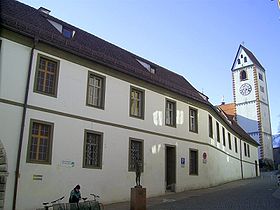 In 1837 the former abbey church was transferred as a gift to the parish of Füssen. In 1839 the Royal Bavarian
In 1837 the former abbey church was transferred as a gift to the parish of Füssen. In 1839 the Royal Bavarian
chamberlain, Christoph Friedrich von Ponickau, bought the remaining lordship of St. Mang. In 1909 the town of Füssen acquired the Ponickau estate, including the former abbey buildings (apart from the church).
The north wing was used as the town hall. In the south wing the Füssen Town Museum is now located, with displays on the history of the abbey and of the town, particularly of the traditional manufacture of lutes and violins in Füssen. It is also possible to view the Baroque reception rooms of the abbey in the museum.
Magnus as the founding abbot, and his successor as Blessed Conrad.
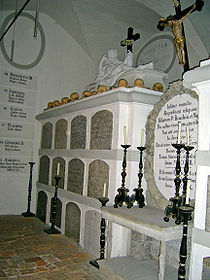

Füssen
Füssen is a town in Bavaria, Germany, in the district of Ostallgäu situated from the Austrian border. It is located on the banks of the Lech river. The River Lech flows into the Forggensee...
in Bavaria
Bavaria
Bavaria, formally the Free State of Bavaria is a state of Germany, located in the southeast of Germany. With an area of , it is the largest state by area, forming almost 20% of the total land area of Germany...
, Germany
Germany
Germany , officially the Federal Republic of Germany , is a federal parliamentary republic in Europe. The country consists of 16 states while the capital and largest city is Berlin. Germany covers an area of 357,021 km2 and has a largely temperate seasonal climate...
.
History


Bishop of Augsburg
The Bishop of Augsburg is the Ordinary of the Roman Catholic Diocese of Augsburg in the Ecclesiastical province of München und Freising.The diocese covers an area of 13,250 km².The current bishop is Konrad Zdarsa who was appointed in 2010....
. The reason for its foundation goes back to the hermit
Hermit
A hermit is a person who lives, to some degree, in seclusion from society.In Christianity, the term was originally applied to a Christian who lives the eremitic life out of a religious conviction, namely the Desert Theology of the Old Testament .In the...
Magnus of Füssen
Magnus of Füssen
Saint Magnus of Füssen, otherwise Magnoald or Mang, was a missionary saint in southern Germany, also known as the Apostle of the Allgäu. He is believed to have been a contemporary either of Saint Gall or of Saint Boniface and is venerated as the founder of St. Mang's Abbey, Füssen.-Life:There is...
(otherwise known as Saint Mang), who built a cell and an oratory here, where he died on 6 September, although there is no record of which year.
The saint's body, amid miracles, was discovered uncorrupted, a proof of his sanctity, and the veneration of St. Mang was the spiritual basis of the monastery.
The foundation was not however solely spiritually motivated; there were practical political reasons underlying it as well. The monastery's key position not only on the important medieval
Middle Ages
The Middle Ages is a periodization of European history from the 5th century to the 15th century. The Middle Ages follows the fall of the Western Roman Empire in 476 and precedes the Early Modern Era. It is the middle period of a three-period division of Western history: Classic, Medieval and Modern...
road from Augsburg across the Alps
Alps
The Alps is one of the great mountain range systems of Europe, stretching from Austria and Slovenia in the east through Italy, Switzerland, Liechtenstein and Germany to France in the west....
to Upper Italy
Italy
Italy , officially the Italian Republic languages]] under the European Charter for Regional or Minority Languages. In each of these, Italy's official name is as follows:;;;;;;;;), is a unitary parliamentary republic in South-Central Europe. To the north it borders France, Switzerland, Austria and...
but also in the Füssen Gap ("Füssener Enge", the point where the Lech River
Lech River
The Lech is a river in Austria and Germany. It is a right tributary of the Danube in length with a drainage basin of .Its source is located in the Austrian state of Vorarlberg, where the river rises from lake Formarinsee in the Alps at an altitude of...
breaks out of the Alps) gave it an immense strategic value, which made it of political concern both to the Bishops of Augsburg and to the Holy Roman Emperor
Holy Roman Emperor
The Holy Roman Emperor is a term used by historians to denote a medieval ruler who, as German King, had also received the title of "Emperor of the Romans" from the Pope...
s.
The history of the abbey in the Middle Ages
Middle Ages
The Middle Ages is a periodization of European history from the 5th century to the 15th century. The Middle Ages follows the fall of the Western Roman Empire in 476 and precedes the Early Modern Era. It is the middle period of a three-period division of Western history: Classic, Medieval and Modern...
is principally marked by the efforts of the religious community to maintain a life true to the Rule of St. Benedict amidst the various pressures caused by external social developments. Over time therefore the monks repeatedly embraced various reforms and reforming movements intended to bring about a return to the essentials of the Benedictine life. These reforms mostly resulted in spiritual and economic growth and an increase in the headcount, which in turn brought more building and commissions of artwork.
The energy of the Counter-reformation
Counter-Reformation
The Counter-Reformation was the period of Catholic revival beginning with the Council of Trent and ending at the close of the Thirty Years' War, 1648 as a response to the Protestant Reformation.The Counter-Reformation was a comprehensive effort, composed of four major elements:#Ecclesiastical or...
found lasting expression in the construction of an enormous Baroque
Baroque
The Baroque is a period and the style that used exaggerated motion and clear, easily interpreted detail to produce drama, tension, exuberance, and grandeur in sculpture, painting, literature, dance, and music...
abbey complex between 1696 and 1726, commissioned by Abbot Gerhard Oberleitner (1696-1714), which still today, along with the High Castle (Hohe Schloss), characterises the town of Füssen.
The architect Johann Jakob Herkomer (1652-1717) succeeded in turning the irregular medieval abbey premises into a symmetrically organised complex of buildings complex. The transformation of the medieval basilica
Basilica
The Latin word basilica , was originally used to describe a Roman public building, usually located in the forum of a Roman town. Public basilicas began to appear in Hellenistic cities in the 2nd century BC.The term was also applied to buildings used for religious purposes...
into a Baroque
Baroque
The Baroque is a period and the style that used exaggerated motion and clear, easily interpreted detail to produce drama, tension, exuberance, and grandeur in sculpture, painting, literature, dance, and music...
church based on Venetian
Venice
Venice is a city in northern Italy which is renowned for the beauty of its setting, its architecture and its artworks. It is the capital of the Veneto region...
models was intended to be an architectural symbol of the veneration of Saint Magnus. The entire church represents an enormous reliquary
Reliquary
A reliquary is a container for relics. These may be the physical remains of saints, such as bones, pieces of clothing, or some object associated with saints or other religious figures...
. For the first time in South German Baroque construction the legend of the local saint inspires the suite of frescoes throughout the entire church. The community at the time also set out to make the new church the envy of connoisseurs for the quality of its artworks.
In the second half of the 18th century the community returned to their spiritual, intellectual and social duties with renewed vigour: the cure of souls, scholarship, music and education.
Although the abbey was never able to obtain the coveted Reichsunmittelbarkeit (independence of all lordship except for that of the Emperor), it had a decisive influence as a centre of lordship and economy, cultural and faith life, on Füssen and the whole region.


Dissolution
On 11 December 1802, during the secularisation that followed the Napoleonic WarsNapoleonic Wars
The Napoleonic Wars were a series of wars declared against Napoleon's French Empire by opposing coalitions that ran from 1803 to 1815. As a continuation of the wars sparked by the French Revolution of 1789, they revolutionised European armies and played out on an unprecedented scale, mainly due to...
and the Peace of Lunéville, the princes of Oettingen-Wallerstein were awarded possession of St. Mang. On 15 January 1803 Princess Wilhelmine ordered Abbot Aemilian Hafner to dissolve the abbey and vacate the premises by 1 March of that year.
The contents of the library were shipped off to the new owners down the Lech on rafts. Most of the items are now in the library of the University of Augsburg
University of Augsburg
The University of Augsburg is a university located in the Universitätsviertel section of Augsburg, Germany. It was founded in 1970 and is organized in 7 Faculties....
, except for a small collection of especially valuable manuscripts, which are in the Augsburg Diocesan Archives.
Later history

King of Bavaria
King of Bavaria was a title held by the hereditary Wittelsbach rulers of Bavaria in the state known as the Kingdom of Bavaria from 1805 until 1918, when the kingdom was abolished...
chamberlain, Christoph Friedrich von Ponickau, bought the remaining lordship of St. Mang. In 1909 the town of Füssen acquired the Ponickau estate, including the former abbey buildings (apart from the church).
The north wing was used as the town hall. In the south wing the Füssen Town Museum is now located, with displays on the history of the abbey and of the town, particularly of the traditional manufacture of lutes and violins in Füssen. It is also possible to view the Baroque reception rooms of the abbey in the museum.
List of the abbots of St. Mang's Abbey, Füssen
Until 919 there is no documentary evidence of the abbots of this abbey. Abbey tradition names SaintMagnus as the founding abbot, and his successor as Blessed Conrad.


| Abbot | Period of authority | Date of death |
|---|---|---|
| 1. Saint Magnus | 6 September | |
| 2. Konrad I | ||
| 3. Wolpoto | 9th century ? | 26 April |
| 4. Bernold | 9th century ? | |
| 5. Leutolph | 9th century ? | |
| 6. Gisilo | occurs 919 | |
| 7. Ortolf | 5 April | |
| 8. Heinrich I. | ||
| 9. Gotebold | ||
| 10. Berthold | 23 August | |
| 11. Adalbert | ||
| 12. Wilhelm | c. 1030–1040 | |
| 13. Eberhard | c. 1060–1061 | 11 May 1091 |
| 14. Swidker | ||
| 15. Adalhalm | 1086 | 25 August 1094 |
| 16. Alberich | 23 January | |
| 17. Konrad II | occurs 1160–c.1175 | |
| 18. Heinrich II | occurs 1178–1191 | 19 February |
| 19. Konrad III | occurs 1206, 1218 | 14 July, c. 1218 |
| 20. Dieto (Theodo) | occurs 1219, 1222 | March 1225 |
| 21. Rugger | occurs 1227 | |
| 22. Rudolf von Thalhofen | occurs 1235, 1251 | 22 May |
| 23. Albert | occurs 1255 | 13 March 1256 |
| 24. Hermann I | occurs 1257, 1262 | |
| 25. Hiltebold | occurs 1263, 1283 | 19 October 1284 |
| 26. Konrad IV | occurs 1284, 1285 | |
| 27. Hermann II | occurs 1287, 1295, 1311 | |
| 28. Goswin | occurs 1313, 1317 | 8 July, c. 1318 |
| 29. Heinrich III | occurs 1319, 1335 | December, c. 1336 |
| 30. Ulrich Denklinger | occurs 1336, 1339 | 18 January 1347 |
| 31. Johannes I Hochschlitz | c. 1347 | 11 August |
| 32. Luiprand | occurs 1374 | |
| 33. Friedrich | occurs 1390 | 28 April |
| 34. Johannes II Lauginger | occurs 1392, 1396 | 21 March 1403 |
| 35. Georg I Sandauer | 1397–1410 | 15 February 1410 |
| 36. Yban von Rotenstein | 1410–1426 | 19 May 1439 |
| 37. Johannes III Schmerlaib | 1426–1431 | 16 May 1431 |
| 38. Konrad V Klammer | 1431–1433 | 13 March 1433 |
| 39. Johannes IV Fischer | occurs 1436; res. 1458 | 30 March 1460 |
| 40. Johannes V Hess | 1458–1480 | 1481 |
| 41. Benedikt I Furtenbach | 1480–1524 | March 1531 |
| 42. Joh. Baptist VI Benzinger | 1524–1533 | 8 April 1537 |
| 43. Gregor Gerhoch | 1537–1554 | 4 October 1554 |
| 44. Sympert Lechler | 1554–1556 | 21 November 1560 |
| 45. Georg II Albrecht | 1556–1560 | 2 February 1560 |
| 46. Johannes VII Kessler | 1560–1567 | 8 June 1567 |
| 47. Hieronymus Alber | 1567–1573 | 17 August 1573 |
| 48. Matthias Schober | 1579–1604 | 15 August 1604 |
| 49. Heinrich IV Amman | 1604–1611 | 30 July 1615 |
| 50. Martin Stempfle | 1614–1661 | 26 February 1665 |
| 51. Benedikt II Bauer | 1661–1696 | 26 July 1696 |
| 52. Gerhard I Oberleitner | 1696–1714 | 20 March 1714 |
| 53. Dominikus Dierling | 1714–1738 | 4 September 1738 |
| 54. Benedikt III Pautner | 1738–1745 | 18 January 1745 |
| 55. Leopold Freiherr von Rost | 1745–1750 | 7 November 1750 |
| 56. Gallus Zeiler | 1750–1755 | 7 January 1755 |
| 57. Placidus Zerle | 1755–1763 | 24 June 1770 |
| 58. Gerhard II Ott | 1763–1778 | 1 March 1778 |
| 59. Aemilian Hafner | 1778–1803 | 19 May 1823 |

